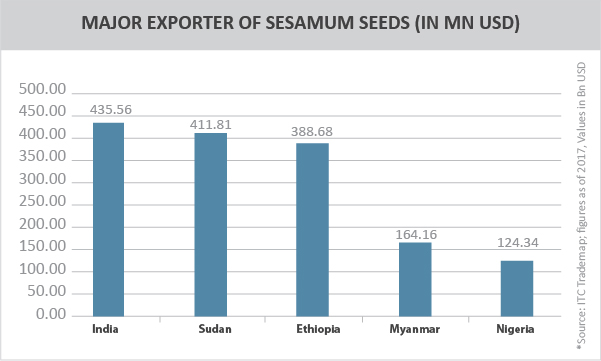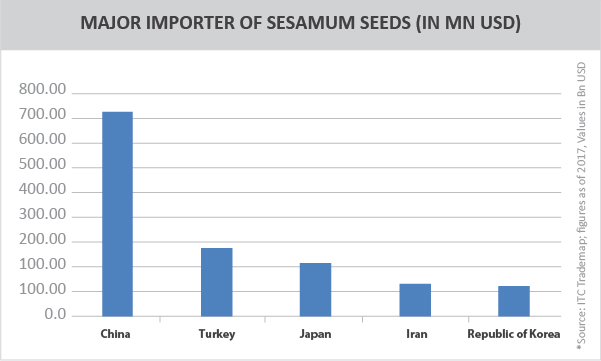Product profile- Sesame seed

Sesame or sesamum indicum L. is commonly known as ‘Till’ in India. Sesame seed is one of the oldest oilseed crops known. It was domesticated over 3000 years ago. It was a major summer crop in the Middle East for thousands of years. Sesame has one of the highest oil contents of any seed. Sesame is drought-tolerant, primarily due to its extensive root system. However, it requires adequate moisture for germination and early growth. While the crop survives drought, as well as presence of excess water, the yields are significantly lower in either conditions. Moisture levels before planting and flowering impact yield most. It is a short duration crop grown throughout the year.
TRADE STATISTICS
Sesame exports sell across a wide price range. Quality perception, particularly how the seed looks, is a major pricing factor.
The major sesame seed exporting nations are-

The major sesame seed importing nations are –

India is the leading producer and exporter of sesame seed. India produces a wide range of sesame seed varieties and grades each peculiar to the region where they are grown. Two distinct types of seed are widely recognized- the white and the black. There are also intermediate coloured varieties varying from red to rose or from brown or grey. The white and other lighter-coloured sesame seeds are common in Europe, the Americas, West Asia, and the Indian subcontinent. The black and darker-coloured sesame seeds are mostly produced in China and south east Asia.
With an annual all season acreage of about 18-20 lakh hectares, India ranks first in both acreage and production (about 8 lakh MT) of sesame in the world. Sesame seeds production is primarily distributed in the states of Gujarat, West Bengal, Karnataka, Rajasthan, Madhya Pradesh, Maharashtra, Tamil Nadu and Andhra Pradesh.
India’s trade trend analysis over the years
India exported US$ 435.6 million while imported US$ 42.9 million of sesame seeds in 2017. India’s sesame seed export to the world saw an upward trend till 2014. In the last decade India’s export reached to US$ 813.6 million in 2014 afterwards it dipped to US$ 477.6 million in 2015 and from there on, it is picking up.
As production varies considerably over the years it significantly impacts the prices. Hence the prices in the Indian markets are determined by demand and supply situation. The export trade needs a reliable forecast of production every year coinciding with the commencement of harvesting operations i.e. in the last week of September. In addition to production figures, the trade also needs information on the quality of the produce which is often adversely affected by the vagaries of weather prevailing during field, harvest and post-harvest stages of the crop. With respect to kharif-2016, a decrease by 14.1% in acreage was observed in kharif-2017 at the national level.
Thus such variance adversely impact the price forecast since India is a key player in global sesame seed market.
Better mechanism to forecast the production of sesame seed accurately may significantly boost India’s exports apart from the measures to boost its yield.













I completely agree, It is great. And I am always surprised when I read posts about the food. This great content. I have learned something powerful today.toor dal plain suppliers